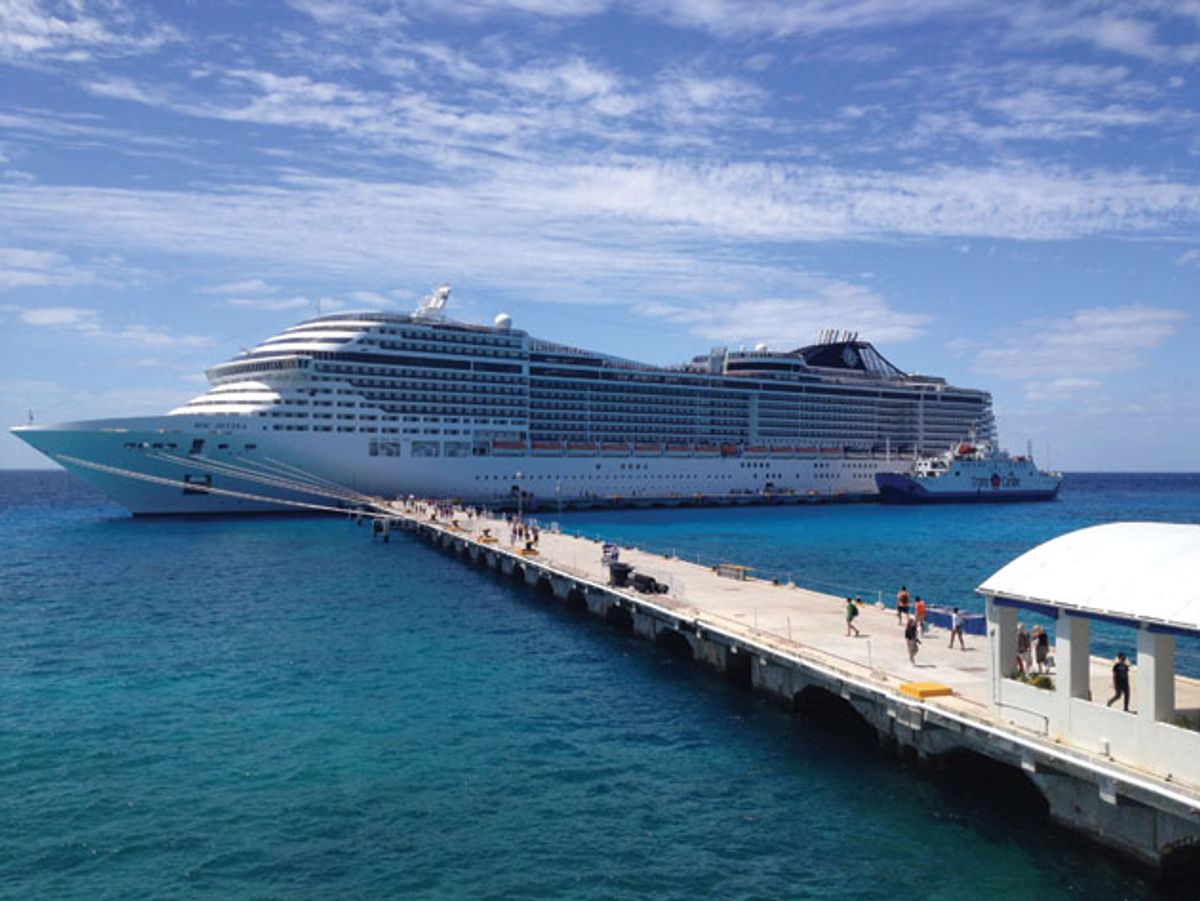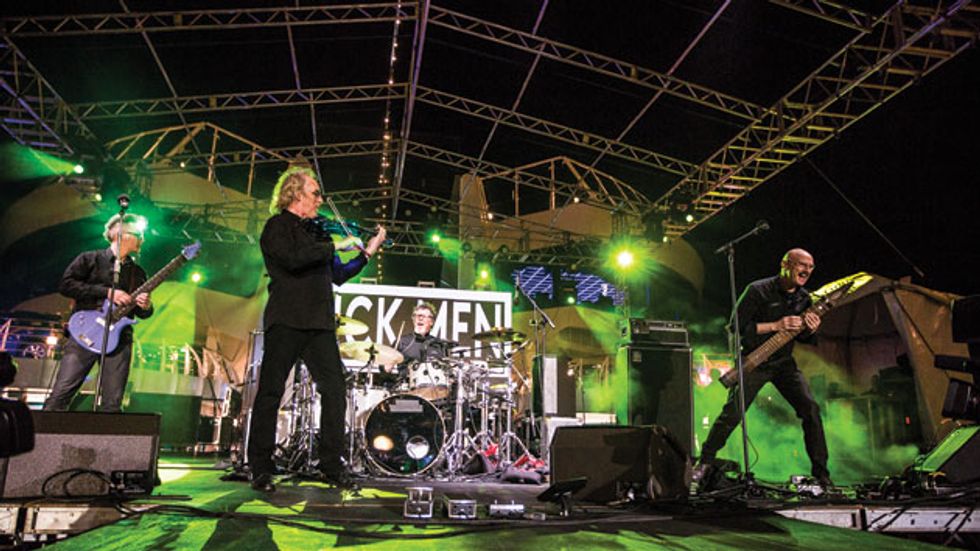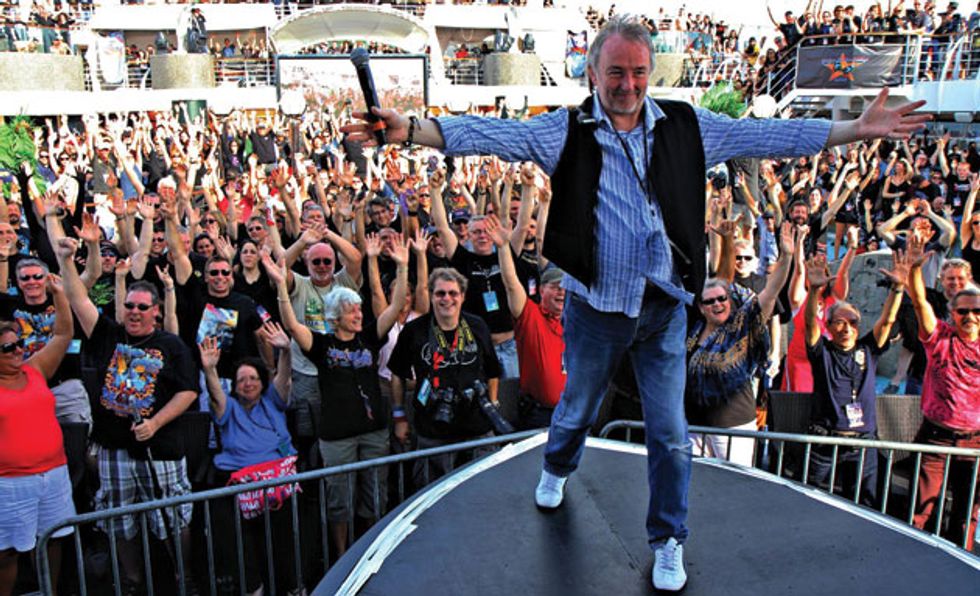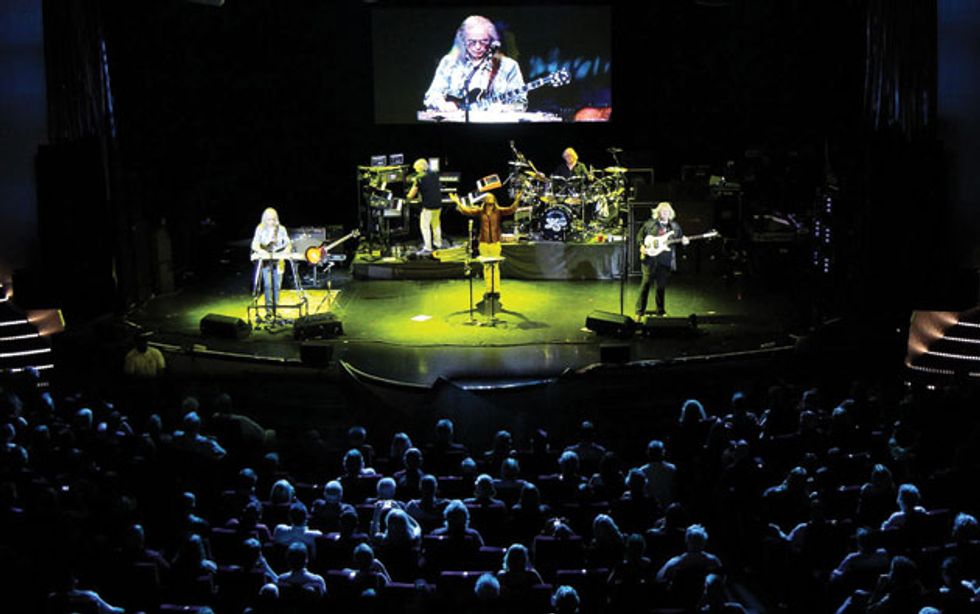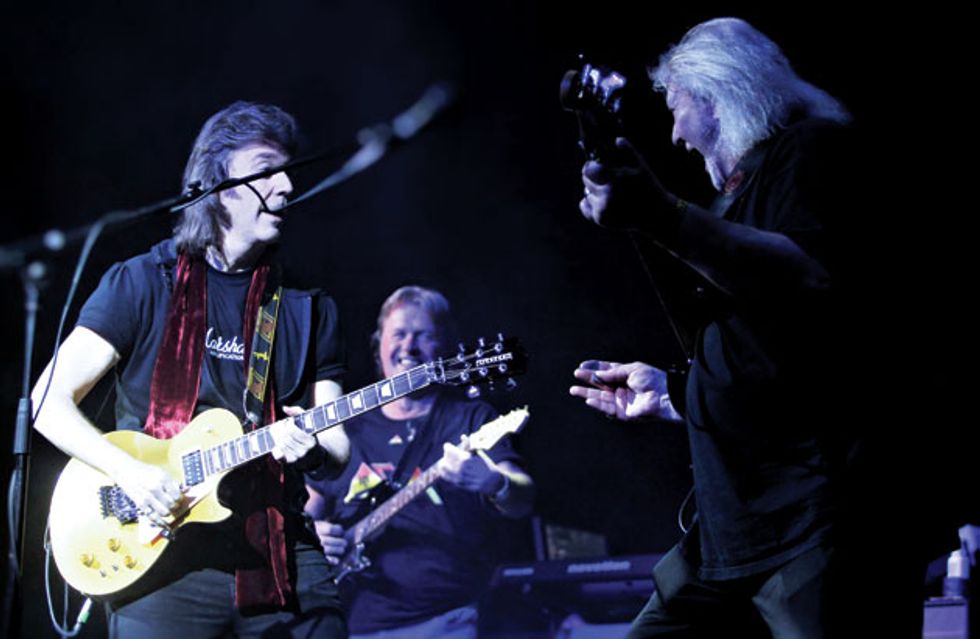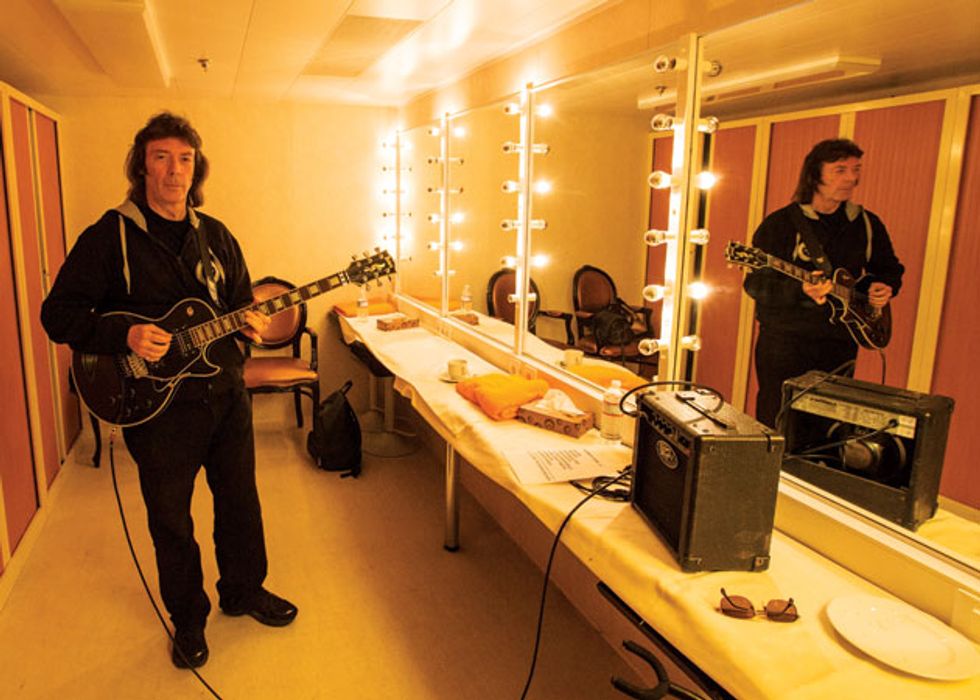Yes hosts a five-day, progressive-rock sea adventure in the Caribbean.
The 11-minute opus that closes Yes’ 1971 album, Fragile, begins with an urgency and chaos of frenetically blended guitar and bass notes that lead into a gentle coo of rolling, rhythmic waves.
With a flick of a wrist, maestro Chris Squire breaks the soft groove with his unusual lead bass guitar, punctuating everything with intensely building lines and a haunting melodic immediacy. The two musical ideas furiously dance until suddenly the former dangerous vibe becomes infectious, and the unpredictable mystique and intrigue of the climb peaks. It’s as if the song is trying to tempt a listener to come along—make the voyage.
“Heart of the Sunrise,” is an appropriate soundtrack to set sail with on Cruise to the Edge, a progressive-rock themed tour of the Caribbean that travels from Miami to Honduras and Cozumel, and back again, in five days. It first set sail in 2013, making its second run in early April this year.
Yes, the band that started it all, are gracious hosts. The spectacle includes mood-setting touches both subtle (like the iconic psychedelic artwork of Roger Dean, which made its way from projector screens to fest-goers T-shirts, to the art gallery at the ship’s top deck) and over-the-top (wizard-themed nights encouraging cruisers to wear capes around the deck).
More than 2,000 guests sailed with about 25 bands, so it appears prog-rock is alive and well. Yes is releasing Heaven & Earth on July 8, with the lineup of guitarist Steve Howe, bassist Chris Squire, drummer Alan White, and Geoff Downes on keys and programming. It’s the group’s 21st studio album, and the first with new vocalist Jon Davison. The plethora of friends they brought along for this boat ride—Marillion, UK, Queensrÿche, Saga, and Italian proggers Premiata Forneria Marconi (PFM), to name a few—are enjoying similar late-career renaissances.
“I don’t think I’ve met anyone who hasn’t said they were happy,” said guitarist Steve Hackett, reflecting the general sentiments of the prog-rock passengers. “Besides perhaps those who’ve fallen over and been horribly injured,” he joked, referring to an apparent mishap on the first Cruise to the Edge in 2013. “Mind yourself on those corridors, the stairs, and the wet patches.”
Lay of the Land
For those who’ve never been on a cruise before (like this writer), the majestic MSC Divina is quite an introduction. Boasting multiple decks, fine-dining restaurants, and even a spa, the European MSC line’s newest ship is like a luxurious ocean-going village. Pair the 24-hour all-you-can-eat buffet with an all-you-can-hear menu of various subgenres of symphonic rock, and what you get is a prog-enthusiast’s dream vacation.
Collaborations made Cruise to the Edge 2014 special. Here UK’s Eddie Jobson is shown playing electric violin with the Stick Men on the Pool Stage. Photo by Armando Gallo.
As the ship glided away from the Port of Miami, guests settled into what would be their home at sea for the next five days. Sporting black Cruise to the Edge T-shirts for the blackout-themed disembarkation party, the fans gathered to hear Saga kick off the music festivities on the Pool Stage. The central and highest performance area on the ship, the Pool Stage featured two-tiered concert seating, lawn chairs, hot tubs, and plenty of island-style booze concoctions.
The music went from sun up to, well, almost sun up. A typical morning might include breakfast at the Manitou buffet, followed by some sunning or a dip in the pool while the first performers welcomed you into the day.
Inside the ship, there were a half dozen stages and more things to see than there was time to see them. The Atrium stage provided a nice focal point in the middle of all the activity, and bands had the opportunity to play a variety of shows: a larger concert, an intermediate lounge show, and a stripped-down acoustic or Q&A/meet-and-greet event in a setting reminiscent of Inside the Actor’s Studio.
The classy Black and White Lounge—one of the midsize venues—would be right at home in a 5-star hotel in Vegas. Outfitted in state-of-the-art furniture, it was a favorite among cruisers for its quaint ambiance. For those who might have had their fill of odd time signatures, other vices were at the ready. One could gamble in the casino, shop in the ship mall, puff it up in the cigar lounge, exercise in the well-equipped gym, or gorge in the fine-dining experience at the Black Crab (with bands like Yes and Genesis playing on the overhead speakers at any given time). And for two days, guests could take excursions like scuba diving or explore the Cozumel port at will. (The Honduras stop was cancelled due to storms this year, but most of the music fans didn’t notice.)
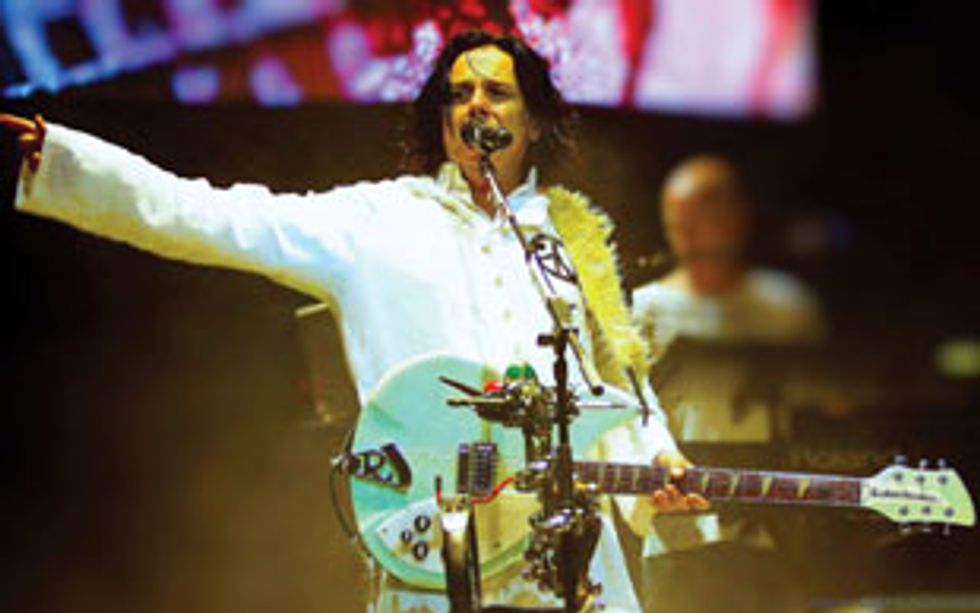
Marillion's Steve Hograth rocking the cruise ship with his Rickenbacker Blue Boy. Photo by Robert Juckett.
Onboard Gems
There was no shortage of intriguing instruments aboard the MSC Divina on Cruise to the Edge, so in the spirit of celebrating aspects of offbeat musicianship, here’s a look at a few eccentric tone toys used on deck.
Blue Boy: Marillion guitarist Steve Hogarth showed off his Rickenbacker 360 with a Blue Boy finish. The 6-string was originally made as part of a limited run of 40 for the U.K. market in 2002. In 2004, Rickenbacker issued the Blue Boy in the U.S.
Touchy Stuff: Let’s be honest, the Stick Men’s touch instruments are a little mysterious. Tony Levin is well known for playing a Chapman Stick, but most people don’t know that it’s a stereo instrument that combines both a bass and a guitar on one fretboard—five or six strings devoted to each on opposite sides. “It’s a touch style, so you don’t pluck it, you just thump it with all your fingers on each hand,” Levin says. “Which means you can play a lot of notes.”
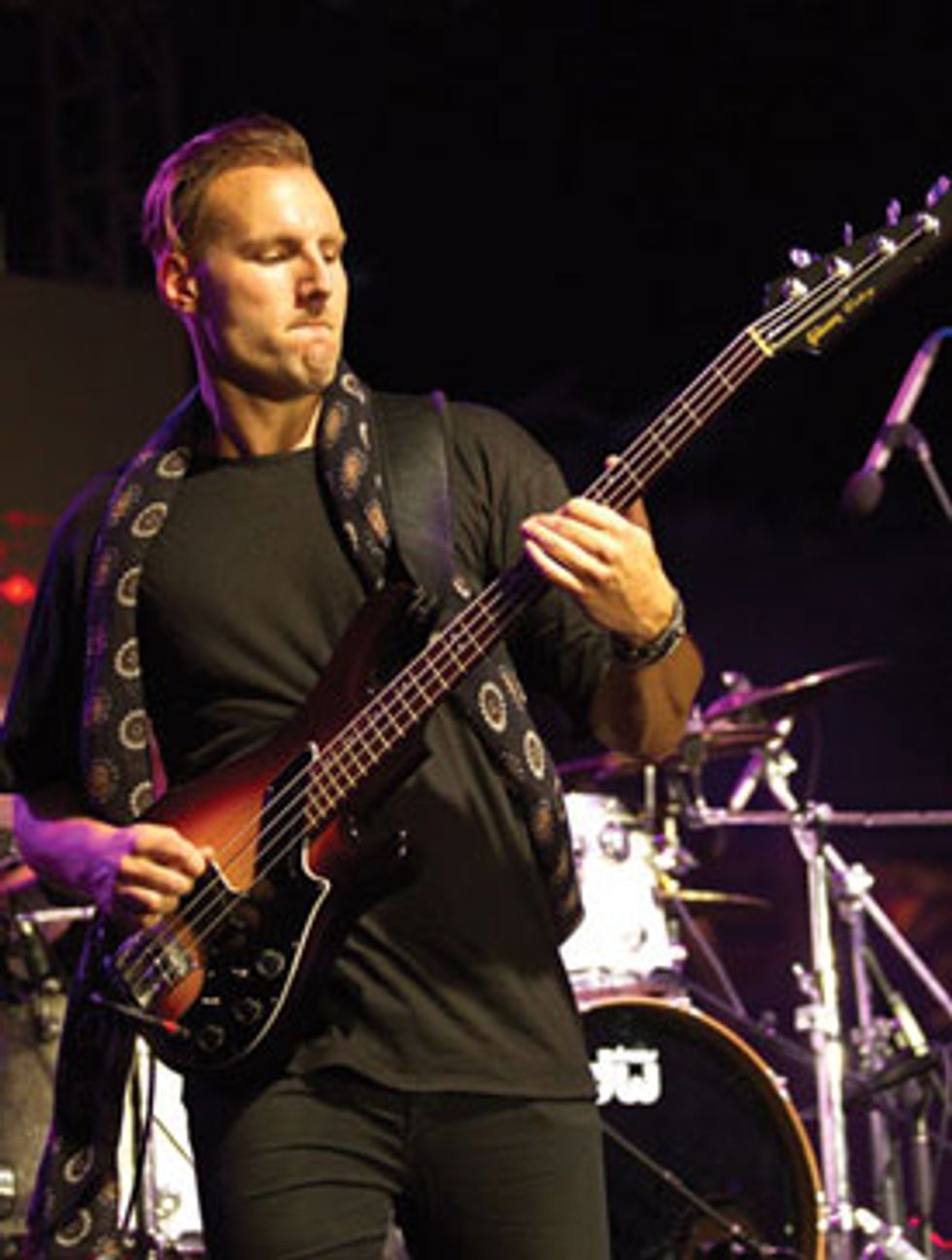
Moon Safari bassist Johan Westerlund grooves with his Gibson Victory bass with Moog electronics, 24 frets, and two active pickups. Photo by Klaus Bornemann
For Tony’s standard electric bass rig, he says doesn’t need an amplifier. “I’m going direct into the house. If there’s an amp onstage it’s just for me. I like the sound of the bass and if I didn’t, I’d be looking for another bass.” The Stick, however, is a little more complex. He runs the bass strings through a compressor directly to the front-of-house, and processes the guitar side with a pedalboard of effects.
Stick Men guitarist Markus Reuter also plays Chapman Stick, but he currently uses his own brand of touch-style instruments that he co-designed with luthier Ed Reynolds. Reuter has two models of Touch Guitars, the U8 and U10. He tunes the middle six strings to the New Standard Tuning (NST) developed by Robert Fripp for his Guitar Craft workshops. “My tuning is mostly in fifths,” Reuter says. “It starts in a low Bb and the top is a minor third and major second.”
Space Bass: Swedish bassist Johan Westerlund of Moon Safari plays something of interest to fans of rare Gibsons. His futuristic, antique fireburst 1981 Gibson Victory Artist bass has 24 frets, two active pickups, Moog electronics, and an unusually shaped pickguard. “It was supposed to be like a Y, which is kind of weird, but it was inspired by Yes,” says Westerlund. “I like the sound. It’s really thundering—it’s like a Precision bass, but with some strange electronics from the ’80s.”
Journalist and rock biographer Jon Kirkman welcomes guests aboard Cruise to the Edge 2014 at the Pool Stage. The ship’s sail-away party included a performance by Saga. Photo by Robert Juckett.
Storytellers
Fans of Steve Hackett enjoyed a rare intimate performance, which he began with a classical guitar composition before launching into his signature “Horizons.” Flawlessly picking his Alvarez Yairi cutaway nylon-string, he closed it out with another Genesis classic, “Blood on the Rooftops.”
For the question-and-answer part of the hour, host Jon Kirkman asked him a few toughies. For example: What do the other former members of Genesis think about Hackett revisiting the group’s music through worldwide tours? Hackett joked they probably just wish they’d thought of it first. But he maintains he does it because he has a great affinity for the discography. “You could either take a competitive approach, or you could say I was in a band with people who were a bunch of fantastic songwriters,” Hackett said. “There wasn’t a duff songwriter amongst the band when I was part of it.”
When a fan suggested that he do the Genesis concept album The Lamb Lies Down on Broadway live, Hackett agreed it was “probably a really good idea.” But new, original music is his focus for the future, and Hackett said he might actually end up being his own opening act on an upcoming tour. He quipped that a third Genesis redux would be “very cheesy.”
Hackett’s two performances in the ship’s formal Pantheon Theatre were full-on shows, with the master guitarist wielding his beloved 1957 goldtop Les Paul as Nad Sylvan belted out Genesis classics like “Dance on a Volcano” and “The Musical Box,” while UK’s John Wetton guested on “Fifth on Fifth.” Hackett was charming and warm throughout, playfully asking his devout followers: “All those numbers in 7/8—can you dance to that?” (Of course they could.) It wasn’t exactly a Squackett reunion when Chris Squire joined his old friend onstage to jam on a rendition of “All Along the Watchtower,” but it was a memorable moment.
During the UK Storytellers session, Eddie Jobson and Wetton discussed their time in King Crimson with Robert Fripp in the early ’70s, as well as UK’s brief life from 1977-80 (the current lineup with drummer Gary Husband and guitarist Alex Machacek reunited in 2011), and also about their time playing with other legendary acts like Roxy Music and Frank Zappa. Wetton performed several acoustic numbers, too, including “The Night Watch.”
There probably weren’t many casual proggers among this crowd, so the caliber went quite high for questions asked by the audience, many of them musicians themselves. Kirkman bravely asked Tony Levin what it was like to work with John Lennon in the studio on Double Fantasy and Milk and Honey before he was killed. While Levin said he had a tough time dealing with Lennon’s death, the working relationship was special—even smooth.
Yes plays in the Pantheon Theatre on Cruise to the Edge. This venue spot was for the flagship shows, which included two big shows per headliner and guests were assigned to one of the shows. Photo by Robert Juckett.
“It was really confrontational in a New York kind of way, and being a New Yorker myself at the time, I was comfortable with that,” Levin shared. “He came right up to me and said, ’They tell me you’re good, just don’t play too many notes.’ And I said, ’Don’t worry, I won’t. We got along excellently because of that.”
Levin and the other two Stick Men—guitarist Markus Reuter (King Crimson) and drummer Pat Mastelotto (King Crimson, Mr. Mister)—discussed their sophisticated instruments [see sidebar, “Onboard Gems”], and Levin even admitted to putting away the fretless for many years when Jaco Pastorious came around. “He played the way I didn’t realize I was dreaming of playing.” Levin also revealed how upright bassist and composer Oscar Pettiford subconsciously informed his work from a young age. (Levin is currently revisiting this early-’50s “cool” jazz influence as a side project with his older brother Pete.)
Many in the audience were curious about Reuter’s multi-instrumental talents, prompting an explanation of why his heart is in guitar. “I love playing the guitar because my finger touches the string directly and I have the impression that the divine influence can go directly into the string and translate.”
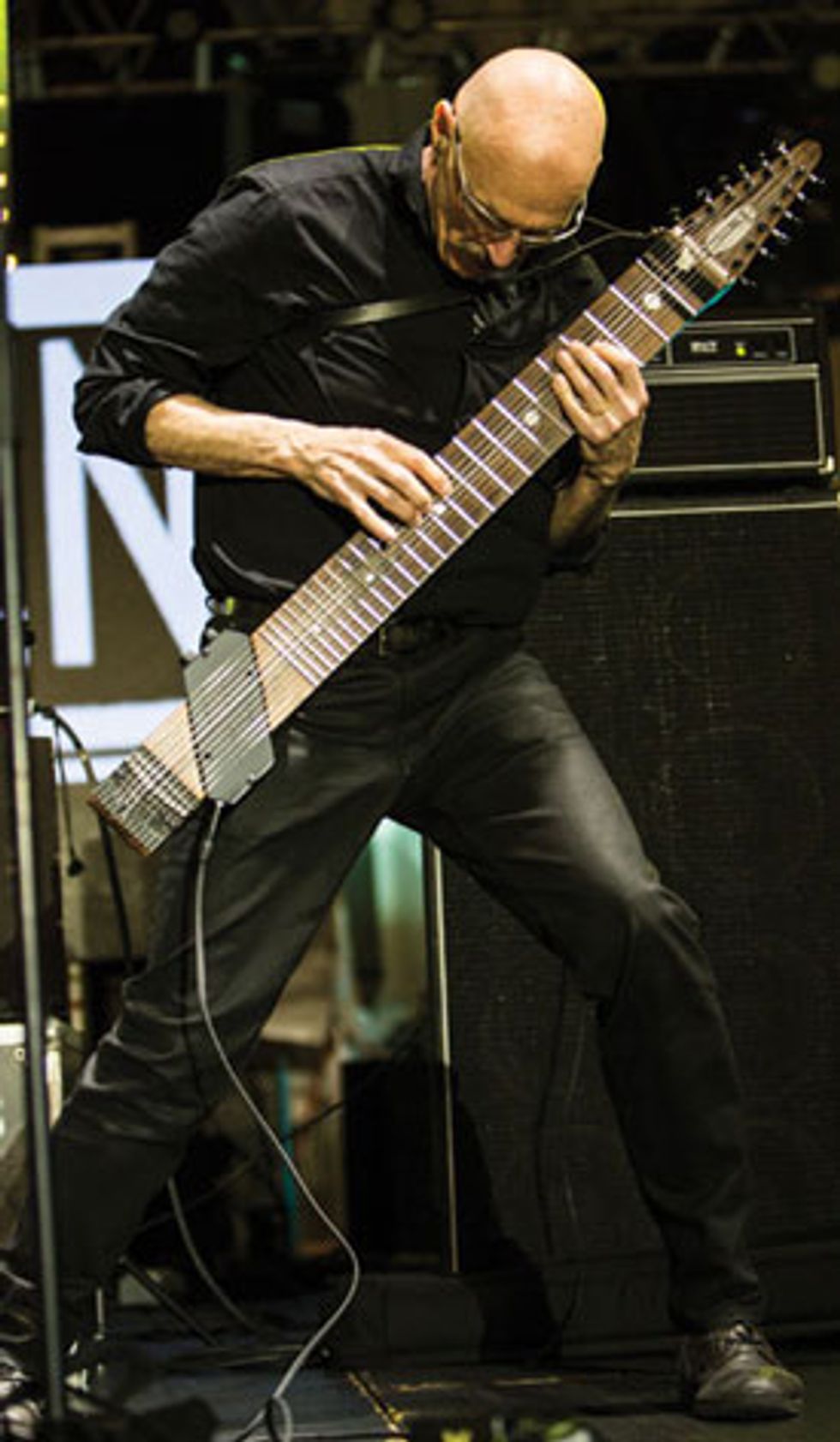
Sea Talk with the Stick Man Tony Levin
How did you become part of the lineup for Cruise to the Edge 2014?
It almost came together the year before, for The Crimson ProjeKCt to play it, but that didn’t work out. So, for this year’s cruise I contacted the promoters and asked if Stick Men could be part of the fun. I’m happy it all worked out.
What were your initial thoughts of the cruise, and how did the actual experience measure up?
I expected it to be fun and relaxing, but it was more of both than I’d expected: Great bands to hear, great facilities, and a very nice atmosphere with all the people who share a passion for progressive rock. I’ve been part of festivals that had many groups playing, but the thing that makes this stand out is sharing the week with the fans and with the bands, and in a setting that’s in itself a lot of fun.
If you were giving a state of the union on the matter of progressive rock …
I’m no expert on the current status of the industry. We in Stick Men, and I, in other projects, just enjoy playing our music. We don’t try to make it specifically fit into a genre, we just make the music we want to be playing. But it certainly is progressive rock, and we can’t help but notice that a lot of those who gravitate to our music also like King Crimson, Yes, and other classic progressive groups.
I can’t predict how the genre will fare in the coming years, but I think that some music takes more effort to get into—to understand—than others, and I think there is an additional value to that complex music, both for the listener and the players. So I’m happy to be enveloped in that adventure, wherever it takes us.
What is the essence of “prog rock” to you?
I keep using the word “progressive”—here’s why. To me, progressive music implies music that’s not settling for the way things have been done, but trying to forge new directions. Terms get complex because the bands that did that back in the ’60s and ’70s—and knocked the socks off many of us who hadn’t heard anything like it—those bands were playing progressive rock that got called “prog rock.”
So, does that phrase refer to music that is looking for new directions, or to music that sounds like those bands did in the ’60s and ’70s?
Both are valid, and there are some great bands doing either or both. For us in Stick Men, we’re not trying to sound like the classic prog bands did, we’re trying to push ourselves to do new things, whether we succeed or not. So it seems to make things clearer to describe that as progressive, rather than prog.
Can you comment on performing at sea? Did any Stick Men get seasick?
We were all, happily, comfortable at sea. The pool show, with high winds, was a challenge … everything needed to be fastened onstage or it’d blow away. But having Eddie Jobson sit in with us on a few pieces and jams more than made up for that distraction.
What were the highlights of your experience? Did you have a favorite stage or other general area on the MSC Divina?
I liked the ship a lot, so I didn’t spend much time in Cozumel. If I had to pick high points, it’d be our opening night in a club … great turnout and a lot of excitement about the music, even though we’d all just arrived on the boat. And just the general days of hanging out among fans of the music. It’s not at all like after shows, because you’re not running off, so there’s none of the hurry that’s there when you meet people after shows.
The Squackett team of Steve Hackett and Chris Squire reunites for “All Along the Watchtower,” with a little help from UK’s John Wetton. Photo by Robert Juckett.
Motion of the Ocean
This event also provided a rare and special opportunity for everyone aboard to socialize and mingle with their fellow passengers.
This wasn’t Kurdt Vanderhoof’s first cruise, but Presto Ballet’s founder and guitarist said it was the first one where he wanted to see every show. “I hate to see it end,” he shared after his performance in the Atrium on the last day of the cruise. “I like all the bands, and I love most of them.” Vanderhoof, whose other band Metal Church is a far cry from the sounds filling the Divina, started Presto Ballet to pay tribute to the progressive rock bands he cut his teeth on. “We’re regressive prog!” he says laughing. “We play regressive rock.”
It can be hard for bands like his to find paying gigs. In fact, Presto Ballet has been around for six years and has released five albums, but Cruise to the Edge was only the group’s fourth live gig. For Vanderhoof, it was the gig: “It’s a boat full of people who are actually going to listen.”
The ship’s relaxed atmosphere provided many opportunities for the relatively young group of musicians in the Swedish sextet Moon Safari to meet some of their heroes. “It’s like talking with your record collection,” says lead singer/guitarist Petter Sandström. “You could just go around with a beer and talk with everyone, and a lot of the old legends would just hang around in bars late at night. I talked a lot with Eddie Jobson. He was hanging at the late-night prog jam almost every night.”
For Moon Safari’s bassist Johan Westerlund, it was a chance to witness some of the greatest trailblazers of adventurous bass playing, like the great Squire. “He revolutionized it,” Westerlund attests. “In the mix of Fragile, you can hear something really strange going on, something that was brand new. They just played all over the place, the guitar can be low … there was no logic to it. It was not the same way it was done before. He used the bass like an actual instrument, not just to fill out the bass range. You can tell that everyone wants to play like him.”
Guitarist Steve Hackett chilling backstage before one of his several performances during the 2014 sea-faring festival.
Photo by Armando Gallo.
And so it would make sense to go to the source and ask the man himself: What is prog? “Generally it’s a term used for anything that’s a bit more complicated than three-chord songs—even though there’s nothing wrong with three-chord songs in their own right,” Squire says. “But prog rock has always had a classical influence, more interesting chord changes, and generally more complicated styles of playing. That’s really what prog rock means to me. I think most artists that have been involved in prog have generally been more clever players than is necessary to be in a lot of rock ’n’ roll, which is all about feel. We in Yes have always developed our interest in that as well, to promote the feel side of music as well as the musicality.”
As Genesis’ “Land of Confusion” played in the background, Vanderhoof offered a heartfelt reason for why he made the trip. “For me, progressive rock is about going against the grain, and music is the main focus. Music is paramount. It’s not about money, it’s not about fashion, it’s not about hits, it’s not about being cool, it’s not about chicks, it’s not about drugs, it’s not about beer—it’s not about any of that. It’s about music.”YouTube It
Go ahead and skip to 1:30 to remember why Chris Squire and Steve Howe are such highly regarded musicians, as Yes plays “Heart of the Sunrise” from their 1971 album, Fragile.
Steve Hackett, Chris Squire, and John Wetton surprise by jamming on “All Along the Watchtower” on Cruise to the Edge 2014.
Moon Safari shows off its six-part vocal harmonies on Cruise to the Edge with “Mega Moon” from their latest album, Himlabacken Vol. 1.
This clip of Italian band PFM gives a view of the ship’s center Pool Stage and also gives a glimpse of the variety of progressive tastes aboard.
